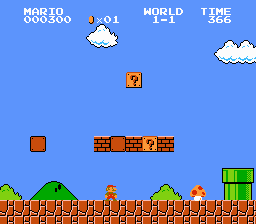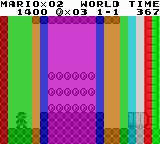A fun fact about most 2D Super Mario platform games is that they all share a common way of storing their level data. A common paradigm as it were. Only the Game Boy games don’t.
 If ROM-based games load so fast compared to disk-based games, why does Super Mario Bros 1 make you wait on a mostly-black screen before you get to play a given level? Why does Super Mario World? Surely it’s doing more than just sitting idly?
If ROM-based games load so fast compared to disk-based games, why does Super Mario Bros 1 make you wait on a mostly-black screen before you get to play a given level? Why does Super Mario World? Surely it’s doing more than just sitting idly?
The answer? Besides graphics in the case of later games, it’s converting the level map from one format to another. From a list of objects to a tile map, to be precise. That brick-block-brick-block-brick line we all know and love from SMB1‘s world 1-1 for example? Five tiles, but only three objects. First, a brick object set to five tiles wide. Then two separate question block objects that overlap the five bricks. On load, these objects are rendered into a tile map.
(Now, SMB1 didn’t have the space to hold an entire converted level in memory and only had a screen or two at once, which is why you can’t backtrack. So in SMB1‘s case, it does in fact sit idly. Thanks to NovaSquirrel for mentioning that.)
While the NES has 8×8 pixel tiles, the map this object list is rendered to has 16×16 pixel tiles. It is what some would call a meta tile map, where each entry itself refers to a different data structure that says “meta tile 2 has this color palette and is built from these four tiles”. That’s the map format a great many games of the era and later use. When an area is about to scroll into view, that tile map is then quickly converted to VRAM-native tiles. And that’s how you can have a set of three coins be defined as one object, yet pick each coin up separately, or have a strip of bricks that you can individually break. And since that alters the big tile map in memory, if you were to backtrack (even though you can’t do that in SMB1, as mentioned, but you can in the later games) those coins and bricks would not reappear.
Sprite objects come in a separate list, usually after the level geometry, and at least for the “classic” games they are subdivided into pages, about a screen wide. They’re only instantiated when their page is just off-screen, and they’re not marked as properly dead. Which is why if you knock out a koopa trooper but leave him there, go about a screen away then double back, the trooper will be back in his starting position and perfectly fine. Your leaving that page made him despawn without marking as properly dead.
 Now, the Super Mario Land games… they do what they want. SML1 for example subdivides levels into screens, which are lists of strips that can be reused at will. I think the screens themselves can also be reused. And that is then converted to a regular tile map. The original Legend of Zelda used a similar strip-based layout.
Now, the Super Mario Land games… they do what they want. SML1 for example subdivides levels into screens, which are lists of strips that can be reused at will. I think the screens themselves can also be reused. And that is then converted to a regular tile map. The original Legend of Zelda used a similar strip-based layout.
I think I remember Super Mario Land 2 used straight-up 16×16 pixel tile maps for its level geometry. Both of these methods are still better than storing several screens worth of tile map in its native size.
Using straight-up tile maps of any resolution is of course a common technique used by many games. As a rule, the larger your levels can be the larger you want your meta tiles to be. Sonic the Hedgehog has positively huge meta tiles, themselves defined in terms of smaller tiles, since your average speed almost requires levels be large to accommodate. And it makes constructing those loops easy as a bonus. Most NES games tend to have 16×16 pixel meta tiles though, because of the attribute map being that size.







